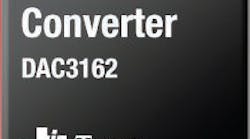Digital-to-analog converters (DACs) are useful in signal generation for a wide range of applications, from consumer electronic devices to advanced military systems. Of course, when it comes to portable systems, power consumption is critical. A new pair of high-speed DACs from Texas Instruments, models DAC3152 and DAC3162, provide dual-channel operation at sampling rates to 500 Msamples/s while using a fraction of the power of competing DACs. Model DAC3152 provides 10-b resolution on both channels while model DAC3162 offers 12-b resolution.
With its acquisition of integrated-circuit (IC) innovator national semiconductor, Texas Instruments now supplies about 25% of the worldwide market for data converters. With the new DAC3152 and DAC3162 models, designers can implement such circuits as direct-digital synthesizers (DDSs) without the usual penalty in power consumption. the higher-resolution DAC3162, for example, consumes just 135 mW power per channel to supply 20 mA output current per channel, and just 67 mA per channel to deliver 2 mA output current per channel. Both DACs can interface directly with additional signal-processing ICs (such as the firm's model TRF370333 analog quadrature modulator) for simple direct-upconversion applications.
Both DACs are supplied in a 48-pin, 7 x 7 mm QFN package (see figure) and feature a simplified interface that eliminates the need for a serial peripheral interface (SPI). In fact, the converters can be operated via simple control, without need of software. The digital data for both DAC channels is interleaved through a single LVDS data bus with on-chip termination. each DAC features an on-chip 1.2-V reference and operates with +1.8 and +3.3 vDc supplies. the on-chip reference only suffers drift of 8 ppm/C.
In terms of performance, both DACs offer clean output signals with very little distortion. For example, the lower-resolution 10-b model DAC3152 achieves typical differential nonlinearity (DNL) of 0.25 least significant bit (SB) and integral nonlinearity (INL) of 0.50 LSB. the spurious-free dynamic range (SFDR) for the DAC3152 is typically −76 dBc for a single tone of 10 MHz, typically −71 dBc for a single tone of 20 MHz, and typically −67 dBc for a single tone of 70 MHz. For the 10-b converter, the third-order intermodulation distortion (IMD3) is typically −86 dBc for two tones at 10 0.5 MHz, typically −81 dBc for two tones at 20 0.5 MHz, and typically −72 dBc for two tones at 70 0.5 MHz. the DAC features typical noise spectral density of −154 dBm/ Hz at 10 MHz and 500 Msamples/s and typically −153 dBm/Hz at 70 MHz and 500 Msamples/s.
The higher-resolution, 12-b model DAC3162 boasts typical DNL of 0.1 LSB and inl of 0.25 LSB. It delivers SFDR of typically −78 dBc for a single tone at 10 MHz, typically −73 dBc for single tone at 20 MHz, and typically −68 dBc for single tone at 70 MHz. It offers IMD3 performance of −86 dBc for two tones at 10 0.5 MHz, typically −83 dBc for two tones at 20 0.5 MHz, and typically −73 dBc for two tones at 70 0.5 MHz. The 12-b converter's noise spectral density is typically −157 dBm/Hz at 10 MHz and 500 Msamples/s sampling rate and typically −154 dBm/Hz at 70 MHz and 500 Msamples/s.
Both converters are specified for coarse-gain linearity of typically 0.04 LSB, gain error of 2% of full-scale reading (FSR), and gain-mismatch of 2% FSR. Each one is characterized by output resistance of 300 kΩ and output capacitance of typically 5 pF. In terms of the time domain, output signals achieve 10-ns settling time at a 500-MSamples/s sampling rate, with 220-ps typical rise/fall times for both converters. Both have low latency of 1.5 clock cycles. Both data converters can be used at operating temperatures from −40 to +85c. P&A: $12.60 (DAC3162) and $9.15 (DAC3152; 1000 qty.); stock.

